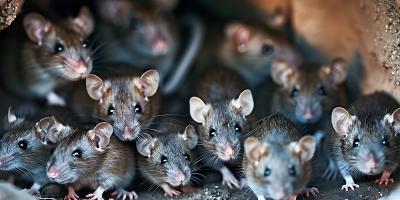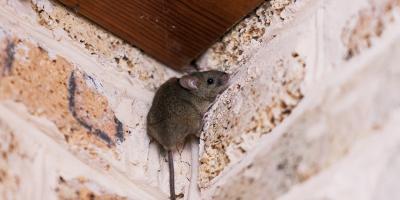Mice In Your Office? Here's What To Do

Keeping your staff productive and on-task requires creating the right work environment - and the presence of pests like mice or other rodents can be a serious damper on your team’s productivity.
Whether your office is located in the heart of the city or on the edge of the forest, mice are a common problem for businesses all across the country. But keeping them away from your workers - and out of your building - can be tricky, especially if you’re not proactively working on prevention strategies.
If you or your workers have spotted mice, seen droppings, or heard scratching within your office walls, it is likely a sign that your building has a rodent problem. Here is a look at what you can do to keep mice from spreading even further, and how to seal off your building from future invasions ahead.
How To Spot The Signs of Mice
While many business owners may have experienced mice issues in the past, it is also true that no two pest problems are ever quite alike. That’s why it’s key to know how to spot the signs of a mouse infestation before the problem gets out of hand.
While you may expect a rodent issue to show itself with individual mice scampering across the floor, the actual signs may in fact be significantly less obvious - but no less harmful.
The first sign of a mouse infestation may be nothing more than some quiet scratching coming from overhead or from inside the walls. This may be the sounds of mice running overhead, a clear sign that they’ve made their way within your walls and ceiling or through your duct system.
Other signs may include the presence of feces or urine around the office, signs of chewing damage on cardboard or electrical cords, or the disappearance of food from eating areas. These should be a clear tip-off that your building may be hosting unwanted rodent invaders.
Block Off Those Common Rodent Roadways
If you believe that your office is unwittingly offering a home for mice and other rodents, the most important course of action is to immediately identify those entry points and block them off from further rodent invaders.
Some of the most useful entry points for mice include openings you may not be likely to notice at first glance. Remember, a mouse can squeeze through openings only a few inches in width, making just about every crack in the foundation or tiny opening around a doorway an easy entryway for hungry mice.
Even more inconspicuous openings for mice can include exterior vents for ductwork, openings for electrical and other cables, and even trucks in your loading bay. It’s critical to make sure no opening exist in these hard-to-spot areas, and to carefully check all food pallets or supplies entering your business to prevent hiding rodents from finding their way indoors.
Don’t Leave Out Open Invitations
As frustrating as a mouse infestation can be for business owners, the real problem may actually begin with your staff not knowing proper prevention practices to keep mice from coming inside in the first place.
Mice come indoors looking for just a few key survival needs: shelter from the elements, and easy access to food and water. There may not be much you can do about the former, but preventing the latter can come down to simple training for your staff and team members.
When it comes to keeping food and water out of the range of mice and other rodents, simple cleaning strategies can make a major difference.
Minimize Food Exposure
Be sure your team members are fully educated on best practices for mouse prevention, including not keeping food or drinks out in the open. That may mean making rules around eating or keeping food around the workplace, or encouraging employees to fully clean their workstations at the end of each day.
Remove Sources of Standing Water
Much like humans, mice and other pests require an easy source of water to make a hiding place worthwhile. The problem for business owners is that these water sources may not always be that apparent, and may even lie out of sight for all but a pest professional.
It’s important to check for leaks in your plumbing system and pooling water around bathrooms, sinks, and other water-holding areas. These hidden water sources can make for easy watering holes for rodents hidden in your walls, so be sure to thoroughly check and act quickly to seal off these leaks before they invite mice indoors.
Keep Your Cleaning Staff On Guard
A general rule of thumb for pest prevention says that dirty spaces tend to make the perfect place for pests to hide out. That’s why it’s critical to make sure your cleaning staff is fully aware of the need for clean spaces and minimal food or water exposure, and to focus particularly on those office areas most likely to attract mice.
One major problem for office owners is the fear that some cleaning staff members may feel in regards to alerting management of pest problems, often out of fear of being reprimanded for speaking out. Because early intervention is key to pest prevention, it’s critical to make sure your staff feels empowered to raise the alarm as soon as the presence of mice is suspected.
Work With An Experienced Pest Professional
As important as early identification may be to your pest prevention strategy, it won’t mean much if you’re not ready to take actions. That’s where working with a pest professional can make a major difference - and may just be the key to keeping mice out of your office.
An experienced pest professional brings a trained eye and knowledge of those hard-to-spot entrances, as well as the skills and tools needed to fully and securely seal off entry points around your building.
But as many business owners know, pest prevention simply cannot start only when there is an issue. That’s why proactive pest prevention may be the key to keeping mice from ever finding their way into your office in the first place.
Our experienced mice prevention specialists at JP Pest Services offer everything from pest removal to seasonal pest prevention for your business. This can help identify weak points in your strategy before mice ever even make an appearance, saving your business the expense and frustration of reactive pest prevention when a problem does arise.
If you’re ready to ramp up your mouse prevention efforts, get in touch and see what our experts can do for your business.



